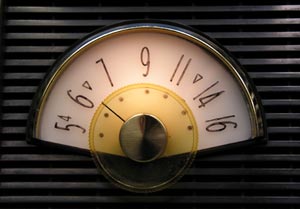
 |
|
|||||||||
|
|
 |
||||||||
 |
Conelrad - What Is/Was That? |
Newsletter Article for the Pavek Museum May - June 2008 Issue |
 If you were around in the 1950's and the early 1960's, you will remember weekly test announcements on radio and television starting with, "This is a test, this is only a test." Conelrad stood for Control of Electromagnetic Radiation otherwise known as the Civilian Defense Emergency Network. Conelrad was used from 1951 to 1963 when it was replaced by EBS, the Emergency Broadcast System. Similar to the Emergency Alert System of today, it was a way of warning the public to danger, especially a nuclear attack, from the Soviet Union during the Cold War. Signaling from station to station was done by shutting a station transmitter off for five seconds, turning it back on for five seconds, shutting it off for five seconds again, then returning it to the air and transmitting a tone for 15 seconds. That was followed by an announcement. Where stations got in trouble, especially TV stations, was with the state of the art of transmitter technology. Turning a transmitter off and on several times in quick succession could result in transmitter failure. Ouch!! After an actual alert was issued, most stations were required to shut down. The remaining stations changed frequency to 640 KHz and 1240 KHz. Remember, that was back in the days of AM radio when FM wasn't yet a player. Changing the frequency on an AM station is an engineering feat unto itself even though it was planned and tested in advance. Those remaining stations would transmit vital emergency information. To further complicate the scenario, stations would transmit for only a few minutes and then shut down letting other stations transmit for a while. The plan was to confuse enemy bomber crews, which might have otherwise homed-in on particular radio stations. This was long before global positioning satellites. If you have an old radio in your garage, you might find is has a circle and triangle "CD" Civil Defense marking on the dial at the 640 and 1240 KHz positions. It was an easy way for the general public to find Civil Defense stations during an emergency. Fortunately, the system was never used for an actual alert. Even though it was tested, I wonder how reliable it would have been in a real life situation. Stations which were designated to remain on the air were stocked with government provided emergency food and other essentials to keep broadcasting. The plan also included concrete bunkers and backup power generators.
Today, even the Emergency Alert System is undergoing
changes. At this time it is designed to be much more reliable and does not
require human intervention at most stations. |
|
Editor's note: Mark Persons is
Certified by the Society of Broadcast Engineers as a Professional Broadcast
Engineer with over 30 years experience. He has written numerous articles for
many industry publications over the years. His website is:
http://www.mwpersons.com
From the Pavek Museum April-May 2008 Newsletter See you further down the road.
I'll leave the soldering iron on for you. Mark Persons ham W0MH. |
|
Questions? Email Mark Persons: teki@mwpersons.com |
|
.